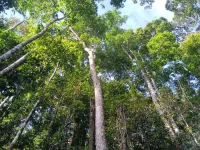(Press-News.org) Researchers have discovered that zinc plays a crucial role in the nitrogen fixation process of legumes. This finding, along with the transcriptional regulator Fixation Under Nitrate (FUN), could revolutionize legume-based agriculture by optimizing crop efficiency and reducing reliance on synthetic fertilizers. By understanding how zinc and FUN regulate nitrogen fixation, researchers might be able to enhance nitrogen delivery, improve crop yields, and promote more sustainable agricultural practices.
The new knowledge about zinc can change the way we cultivate crops, as plants can be made more climate-resilient. This means that the plant can acquire increased tolerance to extreme weather, which can not only ensure a more stable crop yield but also reduce the need for artificial fertilizers and enable the cultivation of legumes in new, previously unsuitable areas.
“Bacteria can cooperate with legumes to fix nitrogen from the air in root nodules. However, the nodules are sensitive to environmental influences such as temperature, drought, flooding, soil salinity, and high concentrations of nitrogen in the soil,” elaborates Assistant Professor and lead author of the study, Jieshun Lin.
Researchers from Aarhus University, Denmark, in collaboration with Polytechnic University of Madrid and European Synchrotron Radiation Facility in France, have discovered that legumes use zinc as a secondary signal to integrate environmental factors and regulate nitrogen fixation efficiency. In the study published in Nature, the researchers discovered that FUN is a novel type of zinc sensor, which decodes zinc signals in nodules and regulates nitrogen fixation.
“It's truly remarkable to discover zinc's role as a secondary signal in plants. It is a vital micronutrient, and it has never been considered as a signal before. After screening over 150,000 plants, we finally identified the zinc sensor FUN, shedding light on this fascinating aspect of plant biology,” Jieshun Lin explains.
In this study the researcher identifies that FUN is an important transcription factor that control nodule breakdown when soil nitrogen concentrations are high: “FUN is regulated by a peculiar mechanism that monitor the cellular zinc levels directly and we show that FUN is inactivated by zinc into large filament structures and liberated into the active form when zinc levels are low,” Professor Kasper Røjkjær Andersen explains.
From an agricultural perspective, continued nitrogen fixation could be a beneficial trait that increases nitrogen availability, both for the legume and for co-cultivated or future crops that rely on the nitrogen left in the soil after legumes are grown. This helps lay the foundations for future research that provides new ways for us to manage our farming systems and reduce the use of nitrogen fertilizer and reduce its impact on the environment.
The implications of this research are significant. By understanding how zinc and FUN regulate nitrogen fixation, researchers are developing strategies to optimize this process in legume crops. This could lead to increased nitrogen delivery, improving crop yields and reducing the need for synthetic fertilizers, which have environmental and economic costs.
Researchers are now investigating the mechanisms of how zinc signals are generated and decoded by FUN. They are looking forward to applying these new discoveries to legume crops such as faba bean, soybean and cowpea.
END
Groundbreaking discovery: Zinc can make crop yields more climate-resilient
2024-06-27
ELSE PRESS RELEASES FROM THIS DATE:
Only 4% of teen football academy prospects make top tier
2024-06-27
Just four per cent of talented teen academy prospects make it to the top tier of professional football, a new study has shown.
A sample of nearly 200 players, aged between 13-18, also revealed only six per cent of the budding ballers even go on to play in lower leagues.
The University of Essex researchers discovered the players who succeeded excelled in self-confidence, ball reception skills, dribbling and coaches’ subjective technical assessments.
The study – published in the International Journal ...
Chinese cities outsourced on others’ efforts to cut carbon emissions
2024-06-27
Experts have identified 240 Chinese cities whose emission reduction are mainly benefiting from the carbon mitigation actions of other cities, whilst putting in less effort themselves.
Researchers studied the phenomenon across 309 Chinese cities using data from 2012 to 2017 – a period when China underwent economic reform and industrial transformation.
Constructing a city-level input-output model to assess carbon footprints, the researchers identified 78% of the cities as ‘outsourced beneficiaries’, ...
Phytochemical diversity and herbivory are higher in tropical forests: Study
2024-06-27
It is widely accepted that biological interactions are stronger or more important in generating and maintaining biodiversity in the tropics than in temperate regions. However, this hypothesis has not been fully tested in ecology and evolutionary biology.
In a study published in Nature Ecology and Evolution, researchers from the Xishuangbanna Tropical Botanical Garden (XTBG) of the Chinese Academy of Sciences have provided strong support for this central prediction by examining phytochemical diversity and herbivory in 60 tree communities ...
Antarctic ice shelves hold twice as much meltwater as previously thought
2024-06-27
Slush – water-soaked snow – makes up more than half of all meltwater on the Antarctic ice shelves during the height of summer, yet is poorly accounted for in regional climate models.
Researchers led by the University of Cambridge used artificial intelligence techniques to map slush on Antarctic ice shelves, and found that 57% of all meltwater is held in the form of slush, with the remaining amount in surface ponds and lakes.
As the climate warms, more meltwater is formed on the surface of ice shelves, the floating ice surrounding Antarctica which acts as ...
First specific PET scan for TB could enable more effective treatment
2024-06-27
A more accurate way to scan for tuberculosis (TB) has been developed by UK and US researchers, using positron emission tomography (PET).
The team, from the Rosalind Franklin Institute, the Universities of Oxford and Pittsburgh and the National Institutes of Health in the USA, have developed a new radiotracer, which is taken up by live TB bacteria in the body. Radiotracers are radioactive compounds which give off radiation that can be detected by scanners and turned into a 3D image.
The new radiotracer, called FDT, enables PET scans to be used for the first time ...
Ammonites’ fate sealed by meteor strike that wiped out dinosaurs
2024-06-27
Ammonites were not in decline before their extinction, scientists have found.
The marine molluscs with coiled shells and one of palaeontology’s great icons flourished in Earth’s oceans for more than 350 million years until they died out during the same chance event that wiped out the dinosaurs 66 million years ago.
Some palaeontologists have argued that their demise was inevitable and that ammonite diversity was decreasing long before they went extinct at the end of the Cretaceous.
However new research, published today in Nature Communications and led by palaeontologists at the ...
New mathematical model sheds light on the absence of breastfeeding in male mammals
2024-06-27
Being nursed by a single parent could be an evolutionary strategy to curb the spread of harmful microbes in mammals, according to a novel theory developed by mathematicians.
The rainforests of Malaysia are home to the only known case of a wild male mammal that produces milk. The Dayak fruit bat is a vanishingly rare case of male milk production, despite the fact that the potential for breastfeeding remains in place in most male mammals.
In the 1970s, evolutionary theorists posited that the near absence of ...
Ammonites went out with a diverse bang—and not a long, slow fizzle—in the Late Cretaceous
2024-06-27
Los Angeles, CA (June 27, 2024) —A new study published in the journal Nature Communications led by paleontologists at the University of Bristol along with a team of international researchers, including Dr. Austin Hendy, Curator of Invertebrate Paleontology at the Natural History Museum of Los Angeles County, finds that instead of fizzling out ahead of their extinction, ammonoids were still going strong across the globe in the Late Cretaceous. Made possible by museum collections, the new study compared their diversity across the globe just prior to extinction, unearthing the complex evolutionary history ...
Cleveland Clinic launches wellness and diet coaching app featuring state-of-the-art food and fitness tracking, support and education
2024-06-27
Embargoed until 4am EDT Cleveland, OH (Thursday, June 27, 2024) – Cleveland Clinic and app developer FitNow, Inc. have launched the Cleveland Clinic Diet app, which offers health and diet advice built upon evidence-based nutrition science and clinical success, paired with a comprehensive food and fitness tracker.
The app provides individualized guided support with the input of Cleveland Clinic health experts to help users make sustainable changes to their lifestyle and dietary habits for better health and well-being.
“We know that health is about far more than just weight. ...
Light-controlled artificial maple seeds could monitor the environment even in hard-to-reach locations
2024-06-27
Researchers from Tampere University, Finland, and the University of Pittsburgh, USA, have developed a tiny robot replicating the aerial dance of falling maple seeds. In the future, this robot could be used for real-time environmental monitoring or delivery of small samples even in inaccessible terrain such as deserts, mountains or cliffs, or the open sea. This technology could be a game changer for fields such as search-and-rescue, endangered species studies, or infrastructure monitoring.
At Tampere University, Professor Hao Zeng and Doctoral Researcher Jianfeng Yang ...








